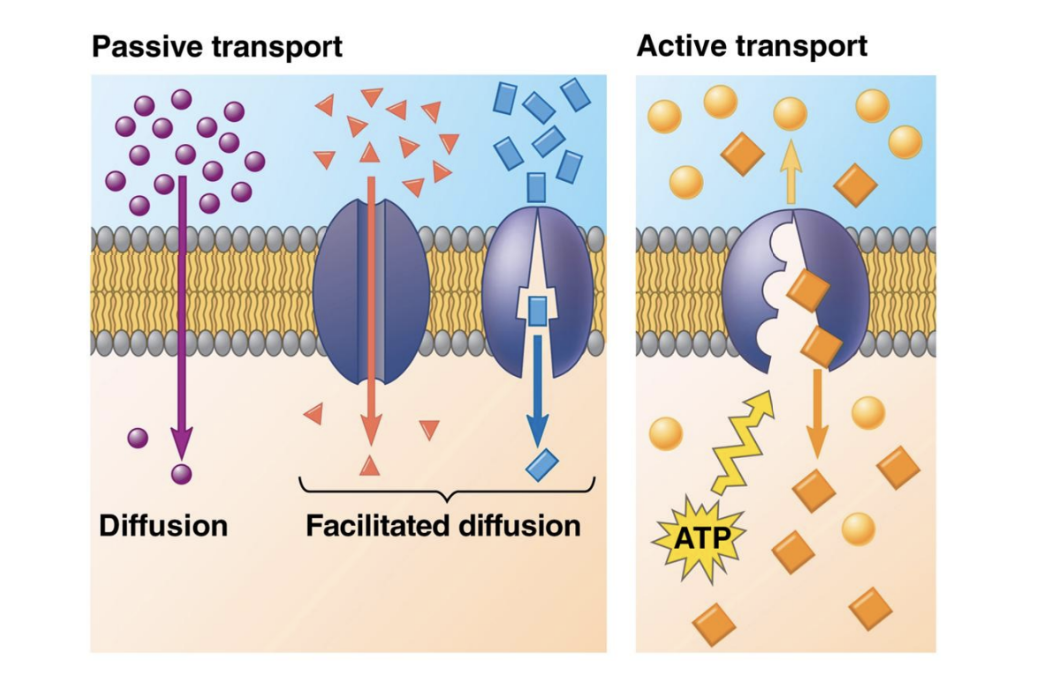7 Membranes Lecture Slides
Chapter Overview
Topic: Membrane Structure and Function
Membrane Traffic Regulation
Movement Across the Plasma Membrane
Small molecules can pass through the plasma membrane via two mechanisms:
Passive transport: No energy required.
May involve transport proteins.
Active transport: Requires energy and a transport protein.
Bulk transport: Involves large molecules using either exocytosis or endocytosis.
Cellular Membranes: Fluid Mosaics of Lipids and Proteins
Structure and Composition
Main Components:
Lipids, proteins, and carbohydrates.
Phospholipids form the basic bilayer of membranes.
Phospholipids:
Amphipathic nature: hydrophobic tails and hydrophilic heads.
Membrane Proteins:
Most proteins are amphipathic, allowing them to interact with both aqueous environments and the lipid bilayer.
Fluid Mosaic Model:
Membranes are a mosaic of proteins in a fluid phospholipid bilayer, with proteins occasionally clustering for specific functions.
Membrane Fluidity
Characteristics
Membranes are held together by hydrophobic interactions.
Lipids can move laterally and occasionally flip across layers.
As temperature changes:
Membranes transition from fluid to solid states based on lipid composition:
Unsaturated fatty acids maintain fluidity, while saturated fatty acids create a more solid membrane.
Cholesterol's Role:
At high temperatures, cholesterol reduces movement of phospholipids.
At low temperatures, it helps prevent tight packing, thus maintaining fluidity.
Evolutionary Adaptations
Membranes adapt their lipid composition in response to temperature changes in the environment,
Example: Fish in cold waters have more unsaturated fatty acids.
Species may modify lipid composition to prevent membrane solidification during temperature fluctuations.
Membrane Proteins and Functions
Types of Membrane Proteins
Two Main Types:
Peripheral proteins: Loosely bound to the surface.
Integral proteins: Span the membrane, including transmembrane proteins with hydrophobic regions that interact with the lipid bilayer.
Functions of Membrane Proteins
Functions include:
Transport
Enzymatic activity
Signal transduction
Cell-cell recognition
Intercellular joining
Attachment to the cytoskeleton and extracellular matrix.
Cell Recognition and Membrane Carbohydrates
Cells recognize each other through surface molecules like glycolipids and glycoproteins, which have attached carbohydrate chains.
These structures assist in cell identification and communication.
Selective Permeability of Membranes
Permeability is determined by:
Lipid bilayer's hydrophobic core that allows nonpolar molecules to pass while impeding polar molecules.
Transport Proteins play a crucial role in the movement of hydrophilic substances across the membrane:
Channel Proteins: Provide corridors for specific molecules.
Carrier Proteins: Bind to molecules and change shape to assist transport.
Passive Transport: Diffusion
Diffusion: Movement of particles from areas of higher concentration to lower concentration.
Concentration Gradient:
Water balance and tonicity affect cell survival and functioning.
Osmosis
Osmosis: Diffusion of water across a selectively permeable membrane, moving from areas of lower solute concentration to higher solute concentration until equilibrium.
Tonicity and Water Balance
Types of Tonicity:
Isotonic: Equal solute concentration
Hypertonic: Higher concentration outside the cell causing water loss and potential cell death.
Hypotonic: Lower concentration outside, leading to water influx that can cause cells to swell or burst.
Active Transport
Definition: Movement of substances against their concentration gradient, requiring energy input (ATP).
Examples:
Sodium-potassium pump maintains essential ion concentrations across membranes.

Cotransport
Active transport can indirectly drive the transport of other solutes via cotransporters, coupling the movement of molecules down their concentration gradient to the active transport of another substance.
occurs when active transport of a solute indirectly drives transport of other substances.
Bulk Transport Mechanisms
Exocytosis: Transport vesicles fuse with the membrane to release contents outside the cell.
Many secretory cells use this to export their products (ex: cells in the pancreas secrete insulin by exocytosis).
Endocytosis: Process of taking in large molecules via vesicle formation. Types include:
Phagocytosis: Engulfing large particles.
Pinocytosis: Uptake of extracellular fluid and solutes.
Receptor-mediated endocytosis: Involves receptors that trigger vesicle formation in response to specific solute binding.
 Knowt
Knowt